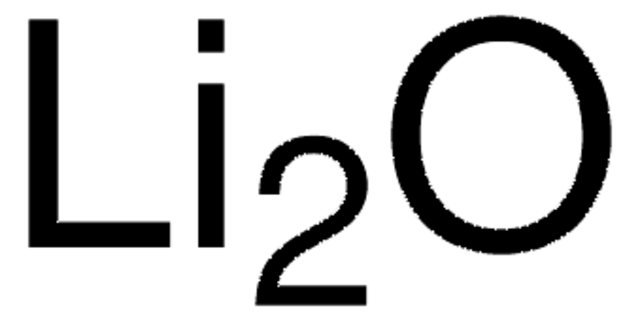931942
Lithium carbonate
battery grade, ≥99.9% trace metals basis
Synonym(s):
Lithium carbonate, Carbolithium, Carbonic acid lithium salt
About This Item
Recommended Products
grade
battery grade
Quality Level
Assay
≥99.9% trace metals basis
greener alternative product characteristics
Design for Energy Efficiency
Learn more about the Principles of Green Chemistry.
sustainability
Greener Alternative Product
mp
618 °C (lit.)
greener alternative category
SMILES string
[Li+].[Li+].[O-]C([O-])=O
InChI
1S/CH2O3.2Li/c2-1(3)4;;/h(H2,2,3,4);;/q;2*+1/p-2
InChI key
XGZVUEUWXADBQD-UHFFFAOYSA-L
Looking for similar products? Visit Product Comparison Guide
General description
Lithium carbonate is an important industrial chemical, primarily as a precursor to lithium fluoride and lithium hydroxide, key precursors for compounds used in lithium-ion batteries. It is also used directly in ceramic glazes, glasses, and fireworks, among other industrial applications.
Lithium carbonate is produced in several ways, usually involving extracting lithium from the earth. One common extraction method involves mining and acid leaching from spodumene ores (lithium aluminum silicate). The ore is concentrated, baked at high temperature to change the crystal structure to a digestible phase, then digested with sulfuric acid to form a concentrate. Reacting the lithium sulfate concentrate with sodium carbonate forms the raw lithium carbonate that is further purified and dried. Another method involves processing and purifying underwater brine, which is pumped to the surface and dried by passive evaporation. The resulting salts are converted to lithium carbonate and subsequently purified.
Application
Packaging
500 g in poly bottle
Signal Word
Warning
Hazard Statements
Precautionary Statements
Hazard Classifications
Acute Tox. 4 Oral - Eye Irrit. 2
Storage Class Code
13 - Non Combustible Solids
WGK
WGK 1
Flash Point(F)
Not applicable
Flash Point(C)
Not applicable
Choose from one of the most recent versions:
Certificates of Analysis (COA)
Sorry, we don't have COAs for this product available online at this time.
If you need assistance, please contact Customer Support.
Already Own This Product?
Find documentation for the products that you have recently purchased in the Document Library.
Our team of scientists has experience in all areas of research including Life Science, Material Science, Chemical Synthesis, Chromatography, Analytical and many others.
Contact Technical Service





